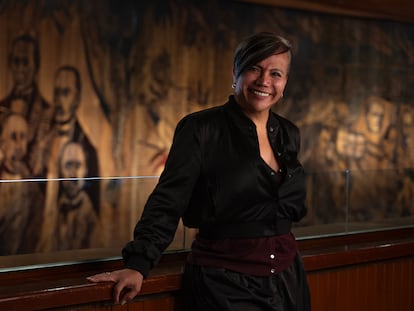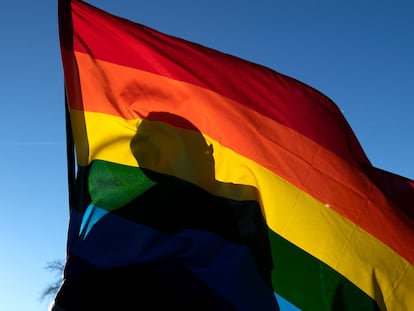The art exhibition combatting violence against the LGBTQ+ community
People who have suffered attacks because of their sexual or gender identity and were welcomed in Mexico see their stories reflected in the exhibition ‘Doors of Hope’

Peruvian Andrés Rícvot remembers the time when his partner, who helped him with his HIV treatment, tried to murder him in France, and he had no one to turn to to save himself. Venezuelan Ángel Trompis has a painful memory of the two weeks he spent lying in the Darién jungle with a broken leg after being expelled from his country because of his gender identity. These instances of violence against the LGBTQ+ community have been portrayed by several artists in seven doors that reflect painful times in the lives of people who found hope in Mexico.
Between the white walls of the Hilario Galguera gallery, where the exhibition Puertas de Esperanza (Doors of Hope) will be on display until January 13, the artist Bárbara Lázara and Rícvot meet again. A conversation between the two created Salvoconducto (Safe conduct), a green door with gold lines that represents the Mexican passport. It is a document that the 34-year-old Peruvian hopes to obtain in two years while he lives at Casa Frida, the non-profit shelter for LGBTQ+ people that welcomed him.
Rícvot accepts his situation: “I am not in Mexico because I wanted to be, but because I was a victim of violence for being gay.” He has a degree in history and now works as a receptionist in a hotel in the capital. In his native Peru, he grew up in a small, very conservative coastal town where he could not reveal his sexual identity. Being HIV-positive, he traveled to Spain in April 2023 to seek treatment against the virus.
In Madrid, he met a Frenchman who took him to Paris to help him with his illness, and they lived together in a country house on the outskirts of the city. It was a home with “all the comforts and luxuries” that soon became a golden cage. His partner became jealous and threatening, and Rícvot could not leave the house. One day, when the two were heading to the hospital, his partner tried to murder him in public.
He had to get out of that situation all by himself. “I didn’t have money, I didn’t have anything. On top of that I had left all my things at his house. He told me that he had all my information, and that if I returned to Peru he would look for me,” Rícvot recalls. Violence also came from the French state. The police told him that it had been a lovers’ quarrel and that there was nothing they could do. They only recommended that he go to the Peruvian consulate. Frightened for his life, he heard something he did not expect: “The consul told me very breezily that this was a typical case for women, and he had never seen it in men.”
The consulate was able to get him a return ticket to Peru with a stopover in Mexico. Rícvot didn’t think twice. “I didn’t want to return to Peru because I knew that person was still after me, so I contacted Casa Frida.” The exhibition’s seven stories of violence came from the shelter for LGBTQ+ people.
“Green is my favorite color,” the Peruvian says. At his side is Barbara Lázara. The artist, who works mainly in dance and theater, had never painted for exhibition. She describes why there is a circle on the hope-colored door that disjoints the straight lines of her work: “They are vanishing points that represent the effort that you have to make to get a passport.”
Escape from Venezuela
43-year-old Venezuelan Ángel Trompis’s door is dark in color. There is another smaller door inside with a screen showing the colors green and blue. The work, Una puerta carecía de cerradura (A door without a lock) by Yupica, a Mexican artist of Japanese origin, is what Trompis saw lying with a broken leg, on his passage through the Darién jungle in 2022.
About 25 years ago, the Venezuelan realized that he was attracted to women. At the age of 13 he revealed it to his mother. At work it was a little more difficult. “In my country there is not much talk about sexual diversity education. We have no rights, we are not heard, we are not really visible. We still live ‘closeted’ lives so that we aren’t judged,” Tromps explains.
He simply modified part of his old name. “I consider myself non-binary transmasculine. My legal name is Angélica María. I identify myself and I like being called Ángel,” he explains. When he lived in Caracas, he couldn’t be who he really was, especially at his job in a Venezuelan public hospital. He was working there one day when was harassed by a colleague. He reported him and he went to jail, but he was released shortly after. Then the threats came from what he calls “collectives,” which he explains are the Maduro regime’s paramilitary groups that have infiltrated every public institution.
The nurse remembers how beautiful his motherhood was. He only shared a brief time with his girlfriend, who died from Hodgkin’s lymphoma when her daughter was one year old. In 2017, he left for Colombia with the 17-year-old girl, returned to Venezuela in 2020 due to his father’s illness, and then left again. In September last year, he decided to cross the Darién to head towards Canada.
During his journey as a migrant, he did not have any problems due to his gender identity. Partly because there were more immediate problems, and he was traveling alone, with almost no contact with other people. The worst was the death trap between Colombia and Panama. “For me, the Darién jungle was a very traumatic experience,” he recalls. When he saw his door, which Yupica created after an interview with Trompis, it reflected that time perfectly.
Although his goal was the extreme north of the continent, he has been in Mexico for a year and feels very comfortable. “Here in Mexico it feels very good to have been given the safety to express myself and identify myself by my gender. I think that in South American countries we are very closed in because there is no open education in sexual diversity,” he says, dressed in a shirt that has the tricolor flag of his host country is printed on it.
The artists
Daniel Dugan is from Alabama, in the United States. The 45-year-old painter and actor has art studios in Mexico City and Los Angeles. When he was contacted with the proposal for Puertas de Esperanza he did not hesitate for a moment. In his southern drawl he talks about a work that reflects the two paths of José, a young gay man who had to flee El Salvador because he suffered verbal and physical violence from his neighbors.
Dugan is known as the labyrinth guy, and his curved lines twist around themselves on different backgrounds on both sides of the door. “As you can see, the door has a dark side, which represents José's most difficult path,” he explains. The labyrinth leads to a small hole in the door that faces the other side, and where the stripes continue on a golden background, which is the path that José now takes in Casa Frida. “José's labyrinth has been very difficult, but his story has been very powerful in creating the work,” says the artist.
Nikky Lee Gálvez is a transgender woman from Honduras who suffered violence from antisocial gangs in her country. Her story is told by 28-year-old artist Alexis Martínez, originally from Tijuana. His work is called IMMURED. “It is a reflection of the feeling of feeling trapped in a situation from which you cannot escape,” says Martínez. “My exercise was listening to Nikky and taking notes about things that seemed relevant to me on a visual level in order to make the door,” he explains about his creation process, which is very similar to that of other artists in the exhibition.
The exhibition arose from an idea of the LLYC Foundation, which is dedicated to communicating issues of social change. They contacted Casa Frida to highlight the violence suffered by the LGBTQ+ community in the Machine Room of the Hilario Galguera Gallery. It was not easy for Andrés Rícvot to talk about his experience, but he did it for a reason: “I think that together we help our stories serve a positive purpose in making us think a little that we are all people, we all deserve the same treatment, and we are all equals. No matter what we have been through, there will always be doors of hope.”
Sign up for our weekly newsletter to get more English-language news coverage from EL PAÍS USA Edition
Tu suscripción se está usando en otro dispositivo
¿Quieres añadir otro usuario a tu suscripción?
Si continúas leyendo en este dispositivo, no se podrá leer en el otro.
FlechaTu suscripción se está usando en otro dispositivo y solo puedes acceder a EL PAÍS desde un dispositivo a la vez.
Si quieres compartir tu cuenta, cambia tu suscripción a la modalidad Premium, así podrás añadir otro usuario. Cada uno accederá con su propia cuenta de email, lo que os permitirá personalizar vuestra experiencia en EL PAÍS.
¿Tienes una suscripción de empresa? Accede aquí para contratar más cuentas.
En el caso de no saber quién está usando tu cuenta, te recomendamos cambiar tu contraseña aquí.
Si decides continuar compartiendo tu cuenta, este mensaje se mostrará en tu dispositivo y en el de la otra persona que está usando tu cuenta de forma indefinida, afectando a tu experiencia de lectura. Puedes consultar aquí los términos y condiciones de la suscripción digital.
More information
Archived In
Últimas noticias
Mexico seeks to shore up its defenses following US incursion in Venezuela
Hope gives way to uncertainty among Venezuelan exiles in the US after Maduro’s capture
Cubans look to Venezuela fearfully after Trump’s incursion: ‘We could be next’
The operation in Venezuela to capture Maduro threatens to widen the cracks in the MAGA movement
Most viewed
- Alain Aspect, Nobel laureate in physics: ‘Einstein was so smart that he would have had to recognize quantum entanglement’
- Gilles Lipovetsky: ‘If you want to live better and fall in love, take Prozac, don’t look to philosophy’
- Alvin Hellerstein, a 92-year-old judge appointed by Bill Clinton, to preside over Maduro’s trial in New York
- Cuba confirms death of 32 of its citizens in the US attack against Venezuela
- Why oil has been at the center of Venezuela-US conflicts for decades










































